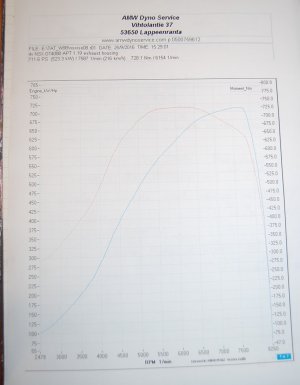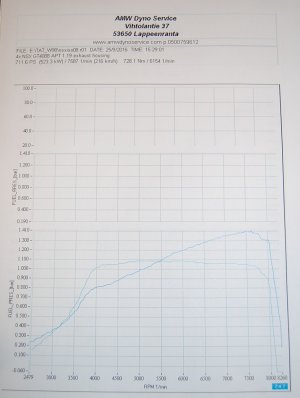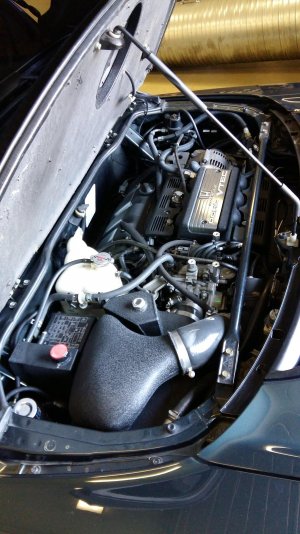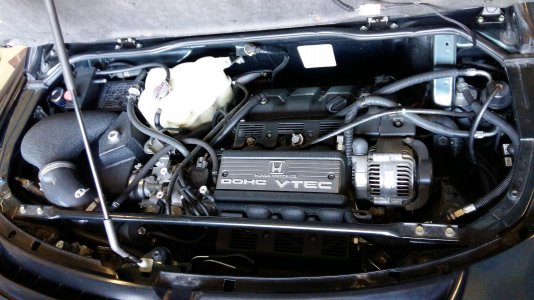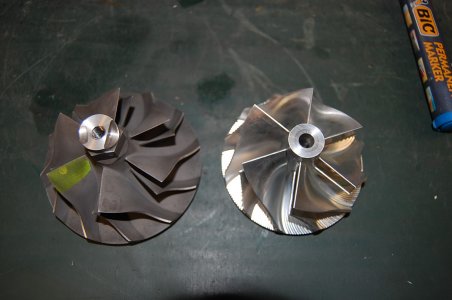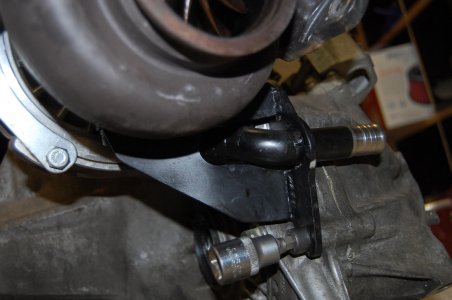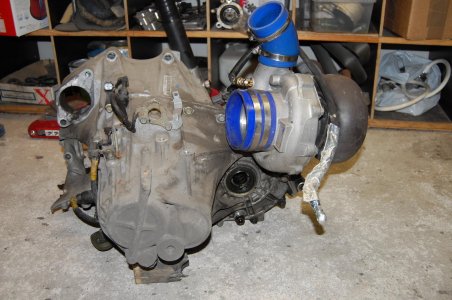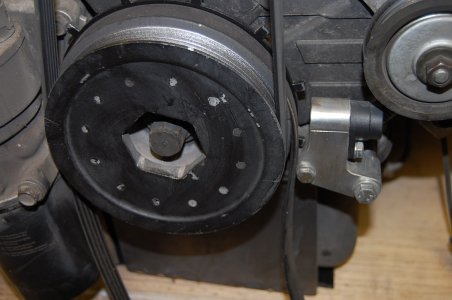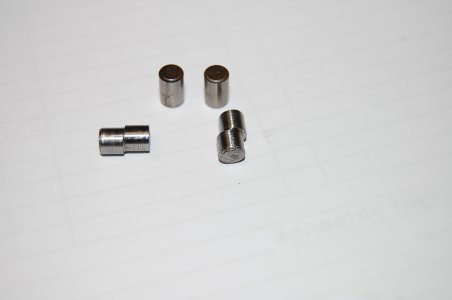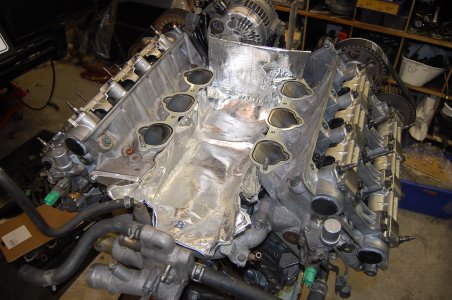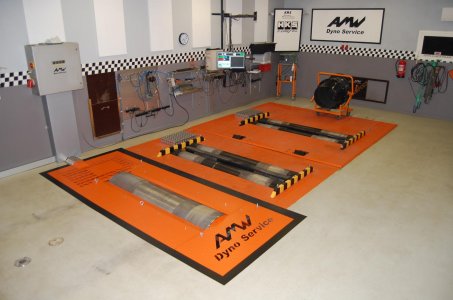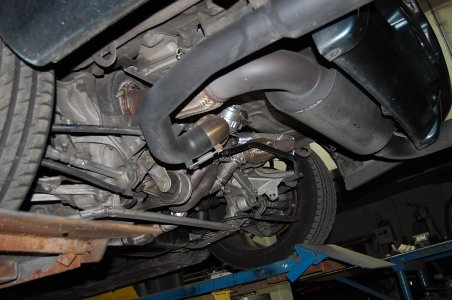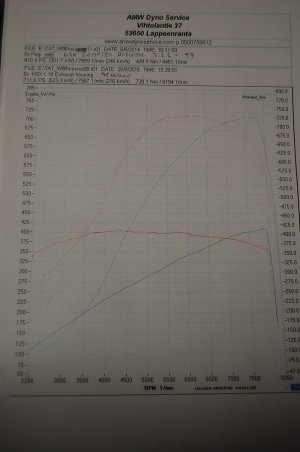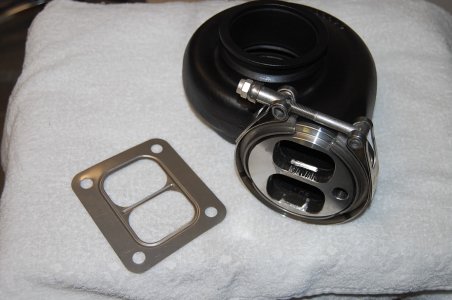MaxEffiency Turbo build
I am a professional car /engine builder and back in 2008, I was looking for car to work with . At first I was looking for supras but I had seen so many of them in my dyno so I lost my interest. It had to be something different that I had seen so far. And so it was ! I bought this ”test bench” car in 2008. It was a very good purchase! I have been working with turbo business for over 30 years so I might have a different perspective to do things than people who normally do their NSX. I have been in dyno about 8000 h and tested countless number of turbos, engines, exhausts, ecus, injectors, pumps etc.
Turbo or supercharger ? Turbo is the only way to go in these days! But only LOW BOOST !
Every thing under 1 bar(14,7 PSI) is LOW boost setup. If you have a good engine, about 80-100 hp / litre it is a good starting point for low boost/high power system. At one bar you normally double your NA power if everything is done right ! It is too easy to make lots of power these days ! So what I was looking for was maximium total package effiencyless than one bar. So lets go …
Engine power is true grankshaft power numbers HP Stock 1994 NSX 268 hp on grank.
Engine setup now is :
-1.Build engine with CP/carillo, cometic, block quard, stock cams, Toda oil pump, steel main caps
-2.Comp.ratio 10.9-11:1 ( oem 10,2) Rev limit 8250.
-3.Engine management HKS F-con V-pro 3.3 ( Pro shop) 32 bit ecu. Closed loop wide band.
-4.BOSCH EV14-1200 cc injectors (finjector) 2x bosch 044 in tank pumps.
-5.Garret GT4088 journal bearing turbo twin scroll 1.09 or 1.19 Turbine housing
-6.Tial 60 mm wastegate ,AMW dump valve
-7.Headers 3-1 309S material ID 36 mm 1,42” inc (OD 40 ) , Y -pipe is316 id 41 mm ( 45 OD)
-8.89 mm 304/409 ( 3,5 ”) light weight exhaust single out put to right side ,WG output is left side
-9.Garret IC water /air 1000hp core
-10.Main trigger wheels is on grank
-11.CAM timing done using OEM gears + ofset pins
-12.Bosch COP coils NGK 7 BKREIX
-13.HEAT management
-14.Mapping
-15.Oil cooling OEM / Castrol oil
-16.Summary of all modifications
Closer look of details :
1. Steel Main caps, Block quard done in 5 axis mill . Very tight tolerace. Bearing running clearances OEM” loose” side . All machine work done my friend Mika .Good machinist is worth of gold! Next engine block guard or Darton > darton less blow by.. much less!
2.Why so high Comp ratio , 11:1 ? There is no reason to lower it if the boost is under 1 bar and heat management is done right way ! Lowering comp ratio will effect your engine effiency in a negative way , Throttle response and how strong your exhaust pulse is >better for turbo turbine side. This is the way to go with these amazing engines!
3.HKS ECU> Our shop has HKS Pro dealer status , so it was a natural choice. 32 bit ecu with damn good and stable inputs , highresolution, Closed loop lambda control.
4.These modern bosch injectors are only injectors what we are using now in all our customers cars. Bosch 044 motorsport pumps in tank . One is is OEM location , one is side of tank inside tank foam ! So foam holds it in place.
5.Turbocharging is all about turbine side pressure control ! What eversystem you do, you need to keep exhaust pressure under boostpressure. Or try to ! Some may say it is not possible but it is. This rule is part of this high compression ratio chosen for. If your turbine pressure is lower than boost, flow is going all the time right direction > out of exhaust valve to turbine.So you are filling cylinders perfectly ! When you exhaust pressure crosses boost pressure(goes over) JUST that point you start loosing torgue ! IN every engine same pattern ! This set up crossing point is 500 rpmhigher. Fresh cool charge in every stroke >you can run very hightiming numbers and this will help to keep exhaust temp low and you will see amazing power numbers. Now let’s look what turbo has good exhaust side up to 700+ hp . Garret GT4088 has biggest turbine wheel in this category. Normally stock garrets are poor sized on turbineside! This turbo has “Good” Turbine/compressor size ratio. Its hould least 1:1 .GT4088 has 64,7/88 (88) compressor. Turbine is70,6/77 mm so ratio is 1.09. I think perfect turbine for this set-up coud be (small dia) 73-74 mm. APT has special V-band output turbine housing for these and this is biggest turbo what you can physically use, very limited place over gearbox/trunk floor where this turbo is located in this set-up .
First testing this turbo from box with 1.09 exhaust housing gave 403 hp at 0,25bar (3,6 psi) so over 120 hp only 0,25 bar ! And boost rise and response was very good . Exhaust pressure data was not ideal because turbo was ”out ”of compressor map !Turbine side was short of energy in that power level but still numbers are good. I could choose BB unit but what I have seen it does not play a very big role if the rest of things are done right. This set up your turbo is using exhaust pulse energy so get max out of it you should have twin scroll turbine like this turbo has. Copressor/turbine wheel> they share they axle ! What ever you do ( or not) it will have effect on both sides!
Now turbo has gone some developments like bigger diffuuser area , smaller compressor big diameter (88>78). This garret has compressor map up to 3 bar! We need only 1 bar so wheel big diameter can be reduced. It could be as small as 72 mm by turbo doctor but I was not so brave to make it so small. Bigger diffuuser cap > less drag > more flow>less turbine pressure because turbine does not need to make so much work. Oil Flow is reduced to turbo.
There is jet before turbo only 1,5 mm. C30A has high oil pressure and I am running only low boost and avoid any smoke from oil burning in your turbine this will cure the problem.
6.Tial 60 mm wastegate. You need big gate to controlling boost in this low pressure exhaust system! Now you need to get pulse out, not pressure.
7.NA headers are for NA cars not turbos ! Primary diameter is in this set only 36 mm ID (1,42) It coud be smaller , but this is best size for this power level. It will be good over 1200 hp. You primary concerns is always turbine sizing. Turbine is the place where you make your exhaust back pressure ! Small primary has fast flow >secondary pipe is 41 ID same rules , high flow is need for turbine. Bigger is not always better in this area. 309S is one off the best material for turbocharger headers. Next best is inconel but it is only for big money race teams. Turbo is connected to side of gearbox. It does not move so there is two special flex joints in both secondary pipes.Wastegate outputs are in outside corner of bend toget exhaust pulse out of turbine. Sceamer pipe is 63,5 mm( 2,5”) T4Flange is 12 mm 304 .
8.Exhaust pipe after turbo has to be as big you can make ! 3 ” is good up to 500 hp . If you have sceam pipe 600 hp is max. Over 600you need 3,5” ( 89 mm) or 4” . Back pressure after turbo has tobe less than 0,05 bar bigger is always better ! This set-up has 89mm(3,5”) exhaust and it is only 1,5 m long . Hand made straight tru SS mufler. Tree layers of absorbing material provide perfect sound !
9.Intercooler front heat exchanger is only 16 mm thick. 250 mm tall and as wide as frame rails. This16 mm thick core does not have effect on engine radiator. Intercooler coolant temp is only1-5 degrees above ambient (celsius). Bosch coolant pump and 15 mm id hoses. Hoses runing tunnel and these hoses are in polyurethane insulation foam tube .Tunnel gets very hot but this polyurethane tubing blocks all heatwhat may cause problem. Part of heat management. Works damn good. Heat soak is problem if car does not move but I run pump always whenignition key is on this helps.
Intercoolerend tank design is critical! If you don’t pay attention flow goesthrough the core using only 10% off its surface area ! There is nopoint to make 10% charge cooler.
There is two ways cure this problem. Using spoilers inside entry tank. It does not harm flow much but this way you coud get ”flat” flowthrough core. It could be tested using a ”garden” blower.
Put only entry tank on using duct tape. You feel how air comes out of core. Or hard expensive way making high flow end tanks like race cars has.(pictures are coming soon)
10. C30A has some problems on grank trigger what is located on cam ! System works ok when engine accelerates fast . Gears 1-4 there is no big problems but when you chance 4>5 or using 5th gear there is point when cam timing system has huge vibrations and that causes timing errors on engine. On airfield you can feel it , data logger has rpm movement 50-120 rpm. Problem is always in same spot 6800-7200rpm. I made new trigger system on grank and now problem is gone and rpm movement is only 0-20 rpms ( HKS datalog value). CAM referencepoint (sync) is still on cam. With new trigger system rpm signal is very stable idle to rev limit you can feel it and hear it ! BUT problem is still there ! Cam timing error does not go nowhere , but now your grank timing is perfect and steady.
Lets look at cam gears. 4 gears and all these are different by weight. Front blanc 4-5-6 exhaust gear is light so is the intake RR 1-2-3 .FF intake gear has timing sensors for both blancks (weird). AND RR exhaust gear is SOLID STEEL. This is clear evidence at this enginehad problems on this area. Heavy gear on RR exhaust cam has some inertia so it dampers vibrations( last one before grank gear) . It will do its job but it is not perfect! So are you “smarter” than HONDA R&D?( If using ligthweight gears) Same way all engine manufacturers do, nothing new. But normally used on diesels on low speed.
11.CAM timing after thinner head gasket and head bloc surface. After this operation cam timing could be way off ! Cometic gasket is 0,76mm , oem is 1,22 + 0.1-0,2 mm surface head and block 0,1-0,2 = total”deck” height could be now- 0,66-0,9 mm ! . Distance to first camgear is now reduced 0.7- 0,9 mm not real bad but RR intake is now 0,9+0,9+0,9= 2,7 mm OFF ! This can be corrected only ONE way. Offset studs on OEM cams gears. Using light gears you could find something ”new” from your engine! Not recommended! If you have lathe it does not cost you nothing to make 5,00 mm offset studs. Or local machine shop can make those too. I made new studs using Mitsubishievo main bolts or old ARP studs or very strong universal bolt about 10mm is good where to start. You need two studs. One to FFex.cam gear 0,3-0,5 mm offset. And one to RR intake 0,9-1,2mm of set. But every engine is different so there is no correct offset. It will take 2-6 hours to make it perfect.
or old ARP studs or very strong universal bolt about 10mm is good where to start. You need two studs. One to FFex.cam gear 0,3-0,5 mm offset. And one to RR intake 0,9-1,2mm of set. But every engine is different so there is no correct offset. It will take 2-6 hours to make it perfect.
Normally I just lock* cams using self made pins before I lock cams I will check that timing marks are perfect. Normally these lockingstuds/holes on cam are very close. I have also a couple offset pins if there is misalignment.*(By shop manual )
12.Stoc coils fresh plugs capped 0,6 mm are good up to 650 hp ...0,4mm cap you may get 700 but never tested. With bosch AMW cop coil set old plugs capped 0,6mm will run what number you want. This spring 0,6 mm cap 2000 km old plugs I could get only 560 hp and then i got misfire. I have 4 set of old NSX coils. Nothing helps. These Bosch cops enginestarts easier, revs like a dream , feels dam sharp, NGK plugs arevery good quality plug to plug so it was my choice. These plugs have5 Kohm resistor :use resistor plugs!
13.Radiator on front / engine middle. Perfect for heat ! Engine surface is 78-90 degrees hot. There is nothing what you could do for it. Exhaust surface is 750-900 deg and it is easy to cover it something..now days plenty of solutions. In this case headers are covered with ceramic heat blanket , Y pipe has ”thermo” tech style wrapping and turbo has ceramic fabric jacket. Charge cooler is located top of transmission and side vent is pushing fresh air into engine bay in that area , Air filter is in same place front of trans. So all ex haust heat is going to turbo> out of exhaust tip. Less turbo lag. Less heat on engine bay.
Intake heat can be reduced using heat insulation between block valley/intake manifold. HUGE gain! It is good idea to use heat spacersbetween head /intake flange. But this area is only 5 % of total intake surface ! Block valley is DAM hot barbigue.
I have a multi layer blanket in that area. Ceramic fabric, polyurethane foam an aluminum covered glassfibre fabric.
This way engine bay gets so cold that you will have problems with you breather hoses on a cold day. Cold day is under 17 deg . Oil,waterand fuel mix cools down in you breather system and may get blocced ! If you have cotton filter it will block for sure ! Needs regular service!
14.Mapping is for professionals only ! One wrong hit on keyboard it will blew up your $20 000 package. Maybe not in dyno but on street or track. This is when experience comes in handy. Leave always some safety margin . Use datalog ! AFR,Oil temps/pressures,Air temps ext. Warning light !
After dyno play wise with compensations ! You can fill up 8-10 mm extra oil in pan. This may help in corners. OIL pan Bafle is MUST !
15.External oil cooler is bad idea if not using huge hoses ! Even AN12 is to small ! I will get back to this later on. I use Castrol 10-60 Edge titanium(former TWS) Same oil in 3 engines .No external coolers, no cam wear ..all looks like new. Oil temp with this oil could beas high as 130-135 ..not over 135 ..or it will die fast . Best idea is the use external engine coolant cooler before OEM engine oilcooler. But I will work on that later on. I have all parts for it. Idid external set so I have cooler and carbon duct from that project.
16.All ends UP. Fine tuning is like circle . Even small chance will effect something else and will end up big gain! But if you choose supercharger/blower not belt driven rotrex with good intercooler there is no way to overcome intake heat problem ! And this is circlewhat goes opposite way could be disaster. It is very hard to tell what is biggest problem on C30A or turbo sety but I would start choosing correct turbocharger to way i just wrote. There may be even better match than this GT4088.
IF this is done wrong the way ..it can’t be solved. Headers,exhaustpipe,cooler. All play they role so all these must be correct.
Grank trigger to crankshaft , Bosch cop coils. Wise tune ! Safety margin...do not pull too much ignition of from base map after dyno. Don’t wash your cylinders ! 11.5 AFR is super safe.
Be sure that your AFR meter is giving correct numbers ! If is it placed too close to turbo or high pressure area ( exhaust backpressure) it will not show correct numbers !
711hp/PS at 1.05 bar (15.22 psi) 728 Nm torg . 98 octane pump fuel
DYNO results at 1.05 bar and pictures how the things look like.(FUEL-PRES is boost and exhaust backpressure)
- - - Updated - - -
2016 set up
I am a professional car /engine builder and back in 2008, I was looking for car to work with . At first I was looking for supras but I had seen so many of them in my dyno so I lost my interest. It had to be something different that I had seen so far. And so it was ! I bought this ”test bench” car in 2008. It was a very good purchase! I have been working with turbo business for over 30 years so I might have a different perspective to do things than people who normally do their NSX. I have been in dyno about 8000 h and tested countless number of turbos, engines, exhausts, ecus, injectors, pumps etc.
Turbo or supercharger ? Turbo is the only way to go in these days! But only LOW BOOST !
Every thing under 1 bar(14,7 PSI) is LOW boost setup. If you have a good engine, about 80-100 hp / litre it is a good starting point for low boost/high power system. At one bar you normally double your NA power if everything is done right ! It is too easy to make lots of power these days ! So what I was looking for was maximium total package effiencyless than one bar. So lets go …
Engine power is true grankshaft power numbers HP Stock 1994 NSX 268 hp on grank.
Engine setup now is :
-1.Build engine with CP/carillo, cometic, block quard, stock cams, Toda oil pump, steel main caps
-2.Comp.ratio 10.9-11:1 ( oem 10,2) Rev limit 8250.
-3.Engine management HKS F-con V-pro 3.3 ( Pro shop) 32 bit ecu. Closed loop wide band.
-4.BOSCH EV14-1200 cc injectors (finjector) 2x bosch 044 in tank pumps.
-5.Garret GT4088 journal bearing turbo twin scroll 1.09 or 1.19 Turbine housing
-6.Tial 60 mm wastegate ,AMW dump valve
-7.Headers 3-1 309S material ID 36 mm 1,42” inc (OD 40 ) , Y -pipe is316 id 41 mm ( 45 OD)
-8.89 mm 304/409 ( 3,5 ”) light weight exhaust single out put to right side ,WG output is left side
-9.Garret IC water /air 1000hp core
-10.Main trigger wheels is on grank
-11.CAM timing done using OEM gears + ofset pins
-12.Bosch COP coils NGK 7 BKREIX
-13.HEAT management
-14.Mapping
-15.Oil cooling OEM / Castrol oil
-16.Summary of all modifications
Closer look of details :
1. Steel Main caps, Block quard done in 5 axis mill . Very tight tolerace. Bearing running clearances OEM” loose” side . All machine work done my friend Mika .Good machinist is worth of gold! Next engine block guard or Darton > darton less blow by.. much less!
2.Why so high Comp ratio , 11:1 ? There is no reason to lower it if the boost is under 1 bar and heat management is done right way ! Lowering comp ratio will effect your engine effiency in a negative way , Throttle response and how strong your exhaust pulse is >better for turbo turbine side. This is the way to go with these amazing engines!
3.HKS ECU> Our shop has HKS Pro dealer status , so it was a natural choice. 32 bit ecu with damn good and stable inputs , highresolution, Closed loop lambda control.
4.These modern bosch injectors are only injectors what we are using now in all our customers cars. Bosch 044 motorsport pumps in tank . One is is OEM location , one is side of tank inside tank foam ! So foam holds it in place.
5.Turbocharging is all about turbine side pressure control ! What eversystem you do, you need to keep exhaust pressure under boostpressure. Or try to ! Some may say it is not possible but it is. This rule is part of this high compression ratio chosen for. If your turbine pressure is lower than boost, flow is going all the time right direction > out of exhaust valve to turbine.So you are filling cylinders perfectly ! When you exhaust pressure crosses boost pressure(goes over) JUST that point you start loosing torgue ! IN every engine same pattern ! This set up crossing point is 500 rpmhigher. Fresh cool charge in every stroke >you can run very hightiming numbers and this will help to keep exhaust temp low and you will see amazing power numbers. Now let’s look what turbo has good exhaust side up to 700+ hp . Garret GT4088 has biggest turbine wheel in this category. Normally stock garrets are poor sized on turbineside! This turbo has “Good” Turbine/compressor size ratio. Its hould least 1:1 .GT4088 has 64,7/88 (88) compressor. Turbine is70,6/77 mm so ratio is 1.09. I think perfect turbine for this set-up coud be (small dia) 73-74 mm. APT has special V-band output turbine housing for these and this is biggest turbo what you can physically use, very limited place over gearbox/trunk floor where this turbo is located in this set-up .
First testing this turbo from box with 1.09 exhaust housing gave 403 hp at 0,25bar (3,6 psi) so over 120 hp only 0,25 bar ! And boost rise and response was very good . Exhaust pressure data was not ideal because turbo was ”out ”of compressor map !Turbine side was short of energy in that power level but still numbers are good. I could choose BB unit but what I have seen it does not play a very big role if the rest of things are done right. This set up your turbo is using exhaust pulse energy so get max out of it you should have twin scroll turbine like this turbo has. Copressor/turbine wheel> they share they axle ! What ever you do ( or not) it will have effect on both sides!
Now turbo has gone some developments like bigger diffuuser area , smaller compressor big diameter (88>78). This garret has compressor map up to 3 bar! We need only 1 bar so wheel big diameter can be reduced. It could be as small as 72 mm by turbo doctor but I was not so brave to make it so small. Bigger diffuuser cap > less drag > more flow>less turbine pressure because turbine does not need to make so much work. Oil Flow is reduced to turbo.
There is jet before turbo only 1,5 mm. C30A has high oil pressure and I am running only low boost and avoid any smoke from oil burning in your turbine this will cure the problem.
6.Tial 60 mm wastegate. You need big gate to controlling boost in this low pressure exhaust system! Now you need to get pulse out, not pressure.
7.NA headers are for NA cars not turbos ! Primary diameter is in this set only 36 mm ID (1,42) It coud be smaller , but this is best size for this power level. It will be good over 1200 hp. You primary concerns is always turbine sizing. Turbine is the place where you make your exhaust back pressure ! Small primary has fast flow >secondary pipe is 41 ID same rules , high flow is need for turbine. Bigger is not always better in this area. 309S is one off the best material for turbocharger headers. Next best is inconel but it is only for big money race teams. Turbo is connected to side of gearbox. It does not move so there is two special flex joints in both secondary pipes.Wastegate outputs are in outside corner of bend toget exhaust pulse out of turbine. Sceamer pipe is 63,5 mm( 2,5”) T4Flange is 12 mm 304 .
8.Exhaust pipe after turbo has to be as big you can make ! 3 ” is good up to 500 hp . If you have sceam pipe 600 hp is max. Over 600you need 3,5” ( 89 mm) or 4” . Back pressure after turbo has tobe less than 0,05 bar bigger is always better ! This set-up has 89mm(3,5”) exhaust and it is only 1,5 m long . Hand made straight tru SS mufler. Tree layers of absorbing material provide perfect sound !
9.Intercooler front heat exchanger is only 16 mm thick. 250 mm tall and as wide as frame rails. This16 mm thick core does not have effect on engine radiator. Intercooler coolant temp is only1-5 degrees above ambient (celsius). Bosch coolant pump and 15 mm id hoses. Hoses runing tunnel and these hoses are in polyurethane insulation foam tube .Tunnel gets very hot but this polyurethane tubing blocks all heatwhat may cause problem. Part of heat management. Works damn good. Heat soak is problem if car does not move but I run pump always whenignition key is on this helps.
Intercoolerend tank design is critical! If you don’t pay attention flow goesthrough the core using only 10% off its surface area ! There is nopoint to make 10% charge cooler.
There is two ways cure this problem. Using spoilers inside entry tank. It does not harm flow much but this way you coud get ”flat” flowthrough core. It could be tested using a ”garden” blower.
Put only entry tank on using duct tape. You feel how air comes out of core. Or hard expensive way making high flow end tanks like race cars has.(pictures are coming soon)
10. C30A has some problems on grank trigger what is located on cam ! System works ok when engine accelerates fast . Gears 1-4 there is no big problems but when you chance 4>5 or using 5th gear there is point when cam timing system has huge vibrations and that causes timing errors on engine. On airfield you can feel it , data logger has rpm movement 50-120 rpm. Problem is always in same spot 6800-7200rpm. I made new trigger system on grank and now problem is gone and rpm movement is only 0-20 rpms ( HKS datalog value). CAM referencepoint (sync) is still on cam. With new trigger system rpm signal is very stable idle to rev limit you can feel it and hear it ! BUT problem is still there ! Cam timing error does not go nowhere , but now your grank timing is perfect and steady.
Lets look at cam gears. 4 gears and all these are different by weight. Front blanc 4-5-6 exhaust gear is light so is the intake RR 1-2-3 .FF intake gear has timing sensors for both blancks (weird). AND RR exhaust gear is SOLID STEEL. This is clear evidence at this enginehad problems on this area. Heavy gear on RR exhaust cam has some inertia so it dampers vibrations( last one before grank gear) . It will do its job but it is not perfect! So are you “smarter” than HONDA R&D?( If using ligthweight gears) Same way all engine manufacturers do, nothing new. But normally used on diesels on low speed.
11.CAM timing after thinner head gasket and head bloc surface. After this operation cam timing could be way off ! Cometic gasket is 0,76mm , oem is 1,22 + 0.1-0,2 mm surface head and block 0,1-0,2 = total”deck” height could be now- 0,66-0,9 mm ! . Distance to first camgear is now reduced 0.7- 0,9 mm not real bad but RR intake is now 0,9+0,9+0,9= 2,7 mm OFF ! This can be corrected only ONE way. Offset studs on OEM cams gears. Using light gears you could find something ”new” from your engine! Not recommended! If you have lathe it does not cost you nothing to make 5,00 mm offset studs. Or local machine shop can make those too. I made new studs using Mitsubishievo main bolts
Normally I just lock* cams using self made pins before I lock cams I will check that timing marks are perfect. Normally these lockingstuds/holes on cam are very close. I have also a couple offset pins if there is misalignment.*(By shop manual )
12.Stoc coils fresh plugs capped 0,6 mm are good up to 650 hp ...0,4mm cap you may get 700 but never tested. With bosch AMW cop coil set old plugs capped 0,6mm will run what number you want. This spring 0,6 mm cap 2000 km old plugs I could get only 560 hp and then i got misfire. I have 4 set of old NSX coils. Nothing helps. These Bosch cops enginestarts easier, revs like a dream , feels dam sharp, NGK plugs arevery good quality plug to plug so it was my choice. These plugs have5 Kohm resistor :use resistor plugs!
13.Radiator on front / engine middle. Perfect for heat ! Engine surface is 78-90 degrees hot. There is nothing what you could do for it. Exhaust surface is 750-900 deg and it is easy to cover it something..now days plenty of solutions. In this case headers are covered with ceramic heat blanket , Y pipe has ”thermo” tech style wrapping and turbo has ceramic fabric jacket. Charge cooler is located top of transmission and side vent is pushing fresh air into engine bay in that area , Air filter is in same place front of trans. So all ex haust heat is going to turbo> out of exhaust tip. Less turbo lag. Less heat on engine bay.
Intake heat can be reduced using heat insulation between block valley/intake manifold. HUGE gain! It is good idea to use heat spacersbetween head /intake flange. But this area is only 5 % of total intake surface ! Block valley is DAM hot barbigue.
I have a multi layer blanket in that area. Ceramic fabric, polyurethane foam an aluminum covered glassfibre fabric.
This way engine bay gets so cold that you will have problems with you breather hoses on a cold day. Cold day is under 17 deg . Oil,waterand fuel mix cools down in you breather system and may get blocced ! If you have cotton filter it will block for sure ! Needs regular service!
14.Mapping is for professionals only ! One wrong hit on keyboard it will blew up your $20 000 package. Maybe not in dyno but on street or track. This is when experience comes in handy. Leave always some safety margin . Use datalog ! AFR,Oil temps/pressures,Air temps ext. Warning light !
After dyno play wise with compensations ! You can fill up 8-10 mm extra oil in pan. This may help in corners. OIL pan Bafle is MUST !
15.External oil cooler is bad idea if not using huge hoses ! Even AN12 is to small ! I will get back to this later on. I use Castrol 10-60 Edge titanium(former TWS) Same oil in 3 engines .No external coolers, no cam wear ..all looks like new. Oil temp with this oil could beas high as 130-135 ..not over 135 ..or it will die fast . Best idea is the use external engine coolant cooler before OEM engine oilcooler. But I will work on that later on. I have all parts for it. Idid external set so I have cooler and carbon duct from that project.
16.All ends UP. Fine tuning is like circle . Even small chance will effect something else and will end up big gain! But if you choose supercharger/blower not belt driven rotrex with good intercooler there is no way to overcome intake heat problem ! And this is circlewhat goes opposite way could be disaster. It is very hard to tell what is biggest problem on C30A or turbo sety but I would start choosing correct turbocharger to way i just wrote. There may be even better match than this GT4088.
IF this is done wrong the way ..it can’t be solved. Headers,exhaustpipe,cooler. All play they role so all these must be correct.
Grank trigger to crankshaft , Bosch cop coils. Wise tune ! Safety margin...do not pull too much ignition of from base map after dyno. Don’t wash your cylinders ! 11.5 AFR is super safe.
Be sure that your AFR meter is giving correct numbers ! If is it placed too close to turbo or high pressure area ( exhaust backpressure) it will not show correct numbers !
711hp/PS at 1.05 bar (15.22 psi) 728 Nm torg . 98 octane pump fuel
DYNO results at 1.05 bar and pictures how the things look like.(FUEL-PRES is boost and exhaust backpressure)
- - - Updated - - -
2016 set up
Attachments
Last edited:


